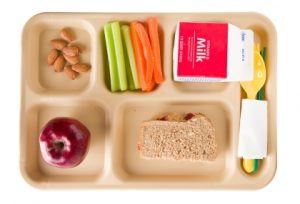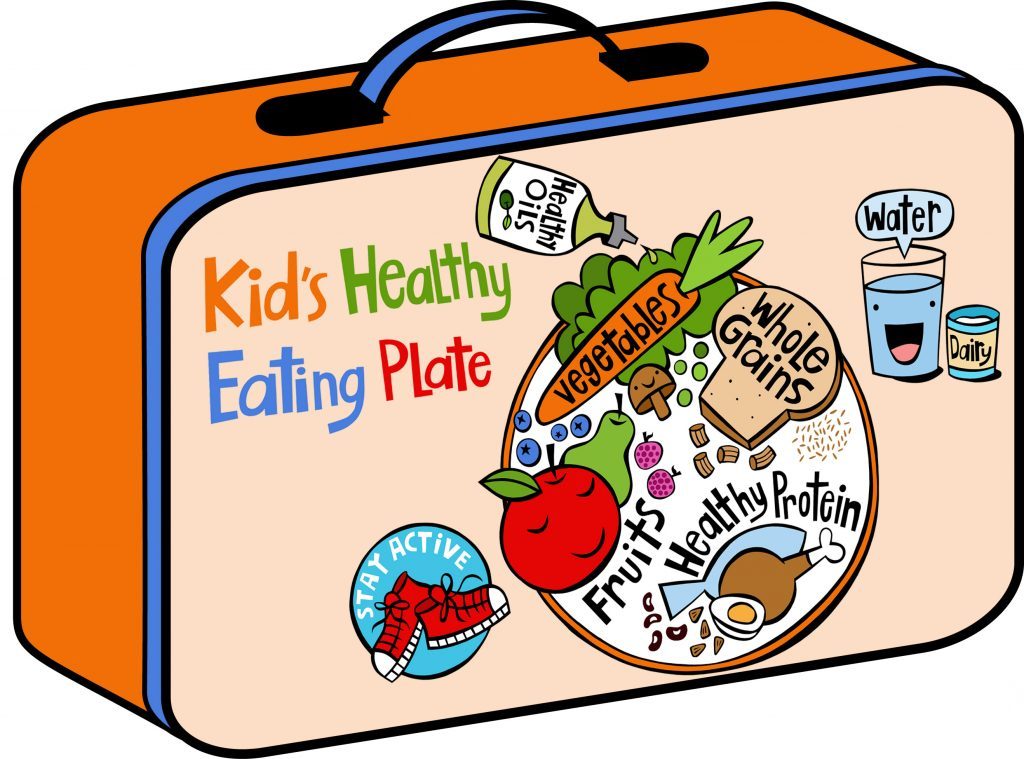 School foods in the U.S. have come a long way. In 2010 they received a complete makeover when The First Lady Michelle Obama spearheaded a school meals initiative, the Healthy, Hunger-Free Kids Act (HHFKA), which was signed into law in December of that year. The act targeted childhood obesity by funding child nutrition programs and setting new nutrition standards for the National School Lunch and Breakfast Programs. The standards, which went into effect at the beginning of the 2012-2013 school year, increased the availability of whole grains, fruits, and vegetables, while increasing the portion sizes of fruits and vegetables offered and making their selection (either a fruit or a vegetable) a requirement. The standards also set grade-specific limits on total calories and sodium contents of the meals, and removed trans fats.
School foods in the U.S. have come a long way. In 2010 they received a complete makeover when The First Lady Michelle Obama spearheaded a school meals initiative, the Healthy, Hunger-Free Kids Act (HHFKA), which was signed into law in December of that year. The act targeted childhood obesity by funding child nutrition programs and setting new nutrition standards for the National School Lunch and Breakfast Programs. The standards, which went into effect at the beginning of the 2012-2013 school year, increased the availability of whole grains, fruits, and vegetables, while increasing the portion sizes of fruits and vegetables offered and making their selection (either a fruit or a vegetable) a requirement. The standards also set grade-specific limits on total calories and sodium contents of the meals, and removed trans fats.
According to the Centers for Disease Control and Prevention (CDC), childhood obesity has more than doubled in children and quadrupled in adolescents in the past 30 years. Weight statistics for children are approaching that of adults: 1 in 3 children is now overweight or obese. Studies have also shown a rising prevalence of type 1 and 2 diabetes in adolescents ages 10 through 19 years, with increasing obesity cited as a key contributor. [1]
On a positive note, the CDC showed a significant 40% decline in obesity rates from 2003 to 2012 in younger children ages 2 to 5 years. [2] Another CDC report revealed a decline in obesity rates among low-income children ages 2 to 4 years participating in federal nutrition programs. [3] Authors from both studies discussed the likely impact of early education programs focusing on improved nutrition and exercise standards, as guided by the HHFKA.
Despite some anecdotal reports in the media that fruits and vegetables from these new updated school meals were ending up in the trash, two studies discovered the opposite. In 2014, Cohen at al. found that children were eating more of their entrees and selecting and eating more fruit. [4] In 2015, Schwartz et al. followed more than 500 children in urban schools in grades 5 through 7, comparing before and after pictures and weights of their school lunches. [5] They found that after two years there was a 19% increase in vegetable intake. Though the amount of fruit eaten did not change, 12% more children were selecting fruits as part of their lunch tray. The authors noted that a greater variety of fruits had been made available, which may have encouraged the children to choose fruit.
Healthier choices throughout the school day
 To further promote healthy eating habits throughout the school day, the USDA released the Smart Snacks in School guidelines that were enforced in September 2014, using science-based nutrition standards required by the HHFKA. They apply to any snack foods and drinks sold to children at school, such as from school stores, vending machines, and in some cases (as determined by the state), fundraisers.
To further promote healthy eating habits throughout the school day, the USDA released the Smart Snacks in School guidelines that were enforced in September 2014, using science-based nutrition standards required by the HHFKA. They apply to any snack foods and drinks sold to children at school, such as from school stores, vending machines, and in some cases (as determined by the state), fundraisers.
According to standards that went into effect in 2016, a Smart Snack must be one of the following:
- A grain product that contains 50 percent or more whole grains by weight (i.e., lists a whole grain as the first ingredient)
- Have as the first ingredient a fruit, a vegetable, a dairy product, or a protein food
- A combination food that contains at least ¼ cup of fruit and/or vegetable
The snack must also meet specific nutrient standards for calories, sodium, sugar, and fats per serving.
When it comes to drinks, allowed beverages include the following:
- Plain water (with or without carbonation)
- Unflavored low fat milk
- Unflavored or flavored fat-free milk and milk alternatives
- 100% fruit or vegetable juice
- Calorie-free, flavored water (with or without carbonation)
- Flavored and/or carbonated beverages that contain less than 5 calories per 8 fluid ounces or ≤10 calories per 20 fluid ounces.
Further modifications beyond these school food standards might include eliminating flavored, sweetened milks and offering only plain milk; limiting fruit juice; providing entrees of poultry, fish, and beans more often than red meat and processed meats; and replacing solid fats with healthful oils such as canola, sunflower, and olive oil when preparing food, salad dressings and sauces.
Parent Tip: How do I know my child is eating their school lunch?
- An important step is to involve your child with meal decisions and maintain an encouraging and non-judgmental attitude to foster open dialogue.
- Most schools provide monthly calendars of their school lunch offerings that include the main meal and alternatives. Discuss each of the choices with your child and highlight the specific foods in the meal they like, dislike, or aren’t sure of. After school, ask what foods they ate and didn’t eat and why. This can help to plan their future meals and snacks.
- Pack nutritious snacks of string cheese, sunflower or pumpkin seeds, whole or chopped fruit, and cut up vegetables that your child enjoys in case they don’t finish the school lunch offering one day. As children respond positively to variety [5], periodically change up the types of fruits and vegetables in their snack bag.
 Create a healthy food chart based off of The Nutrition Source’s Kid’s Healthy Eating Plate, with spaces for fruits, vegetables, whole grains, and healthy proteins. Decide with your kids on a weekly goal for these items. Allow your kids to check off which foods they ate at school and provide small rewards, like stickers, at the end of week if they meet their goals.
Create a healthy food chart based off of The Nutrition Source’s Kid’s Healthy Eating Plate, with spaces for fruits, vegetables, whole grains, and healthy proteins. Decide with your kids on a weekly goal for these items. Allow your kids to check off which foods they ate at school and provide small rewards, like stickers, at the end of week if they meet their goals.- If your child does not consume foods offered at school, here are some tips and inspiration for preparing healthy lunchboxes and snack ideas.

